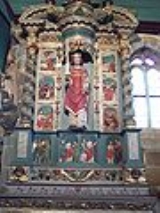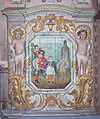
Miliau
Encyclopedia
St Miliau or Milio is a Breton
saint and eponym
of the village of Guimiliau
, where he is particularly venerated. He is said to be a good saint to invoke in cases of rheumatism
. St Miliau is a figure of some importance in Breton cult and legend. He is sometimes represented as a cephalophore
, i.e. holding his own severed head. It is hard to be sure what historical core there might be to the legends.
The legend of St Miliau, as retold in Brittany, pictures him as a good and just prince, slain by his evil brother. Miliau was the son of Budic and grandson of Alain le Long, kings of Armorica
in Brittany. His brothers were Theodoric and Rivod. Miliau is said to have married Haurille and their son was St Melar
. Miliau was famous as a protector and benefactor of the poor, and is represented as dividing his cloak with a beggar, like St Martin of Tours. When he succeeded to the throne, Rivod had him assassinated by decapitation
, around 531. A few years later, Rivod eliminated Melar in the same way.
However, the historical Alan I, King of Brittany, flourished in the 9th century and died in 907. He really did have a son called Budic, who did not succeed him as king. The date 892 is sometimes given for the martyrdom of St Miliau, making him a contemporary of the Carolingian
emperors, rather than the early Merovingian kings. This seems a better fit with the alleged ancestry of St Miliau, and it is reasonable to suppose that Budic might have had two sons who quarreled over their ranking within the kingdom. This dating separates Miliau from St Melar
by more than three centuries. On the other hand, the paternity, and even the geographical origins, of Melar are disputed, and it possible that the connection between the two is based on a misunderstanding.
 A further confusing factor is that St Hervé
A further confusing factor is that St Hervé
, whose date of death (as an old man) is generally given as 556, is also regarded as a native of Guimiliau
. Even the earlier dating for Miliau would make it improbable that Hervé was born in a village of that name, though it would not exclude the possibility that he was born in that locality some time before Miliau.
Brittany
Brittany is a cultural and administrative region in the north-west of France. Previously a kingdom and then a duchy, Brittany was united to the Kingdom of France in 1532 as a province. Brittany has also been referred to as Less, Lesser or Little Britain...
saint and eponym
Eponym
An eponym is the name of a person or thing, whether real or fictitious, after which a particular place, tribe, era, discovery, or other item is named or thought to be named...
of the village of Guimiliau
Guimiliau
Guimiliau is a commune in the Finistère department of Brittany in north-western France.It is noted for its parish close. It should not be confused with the neighbouring commune and village of Lampaul-Guimiliau.-Population:...
, where he is particularly venerated. He is said to be a good saint to invoke in cases of rheumatism
Rheumatism
Rheumatism or rheumatic disorder is a non-specific term for medical problems affecting the joints and connective tissue. The study of, and therapeutic interventions in, such disorders is called rheumatology.-Terminology:...
. St Miliau is a figure of some importance in Breton cult and legend. He is sometimes represented as a cephalophore
Cephalophore
A cephalophore is a saint who is generally depicted carrying his or her own head; in art, this was usually meant to signify that the subject in question had been martyred by beheading....
, i.e. holding his own severed head. It is hard to be sure what historical core there might be to the legends.
The legend of St Miliau, as retold in Brittany, pictures him as a good and just prince, slain by his evil brother. Miliau was the son of Budic and grandson of Alain le Long, kings of Armorica
Armorica
Armorica or Aremorica is the name given in ancient times to the part of Gaul that includes the Brittany peninsula and the territory between the Seine and Loire rivers, extending inland to an indeterminate point and down the Atlantic coast...
in Brittany. His brothers were Theodoric and Rivod. Miliau is said to have married Haurille and their son was St Melar
Melor
Melor was a Breton saint who, in England, was venerated particularly in Wiltshire where he was titular of Amesbury Abbey, which claimed his relics.-Identity:Melor had a popular cult in Brittany, but his story has been obfuscated by a number of biographers who confused...
. Miliau was famous as a protector and benefactor of the poor, and is represented as dividing his cloak with a beggar, like St Martin of Tours. When he succeeded to the throne, Rivod had him assassinated by decapitation
Decapitation
Decapitation is the separation of the head from the body. Beheading typically refers to the act of intentional decapitation, e.g., as a means of murder or execution; it may be accomplished, for example, with an axe, sword, knife, wire, or by other more sophisticated means such as a guillotine...
, around 531. A few years later, Rivod eliminated Melar in the same way.
However, the historical Alan I, King of Brittany, flourished in the 9th century and died in 907. He really did have a son called Budic, who did not succeed him as king. The date 892 is sometimes given for the martyrdom of St Miliau, making him a contemporary of the Carolingian
Carolingian
The Carolingian dynasty was a Frankish noble family with origins in the Arnulfing and Pippinid clans of the 7th century AD. The name "Carolingian", Medieval Latin karolingi, an altered form of an unattested Old High German *karling, kerling The Carolingian dynasty (known variously as the...
emperors, rather than the early Merovingian kings. This seems a better fit with the alleged ancestry of St Miliau, and it is reasonable to suppose that Budic might have had two sons who quarreled over their ranking within the kingdom. This dating separates Miliau from St Melar
Melor
Melor was a Breton saint who, in England, was venerated particularly in Wiltshire where he was titular of Amesbury Abbey, which claimed his relics.-Identity:Melor had a popular cult in Brittany, but his story has been obfuscated by a number of biographers who confused...
by more than three centuries. On the other hand, the paternity, and even the geographical origins, of Melar are disputed, and it possible that the connection between the two is based on a misunderstanding.

Saint Hervé
Saint Hervé of Brittany is a Breton saint of the sixth century. Along with Saint Ives, he is one of the most popular Breton saints. His birthplace is stated as being Guimiliau , and his legend states that he was the son of a renowned bard named Hyvarnion, a former member of the court of...
, whose date of death (as an old man) is generally given as 556, is also regarded as a native of Guimiliau
Guimiliau
Guimiliau is a commune in the Finistère department of Brittany in north-western France.It is noted for its parish close. It should not be confused with the neighbouring commune and village of Lampaul-Guimiliau.-Population:...
. Even the earlier dating for Miliau would make it improbable that Hervé was born in a village of that name, though it would not exclude the possibility that he was born in that locality some time before Miliau.

